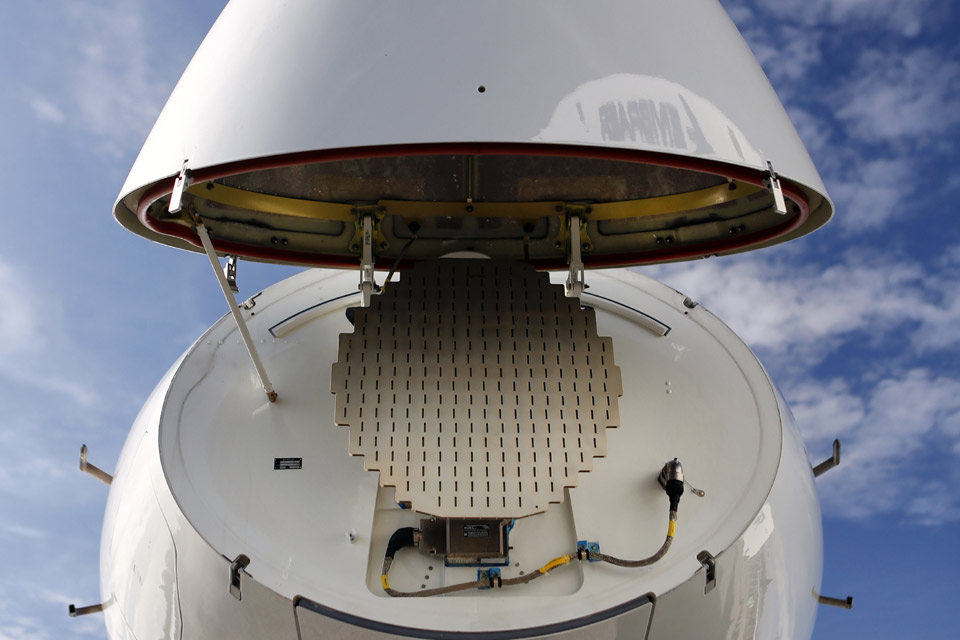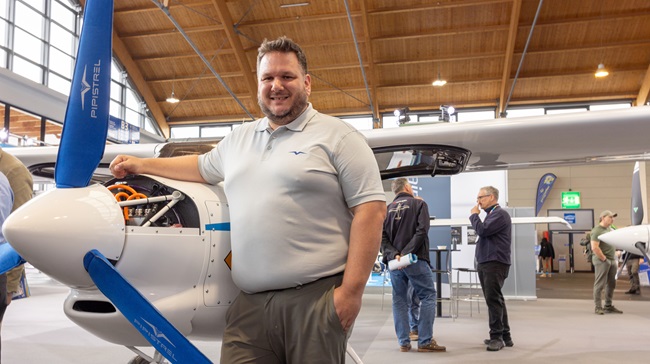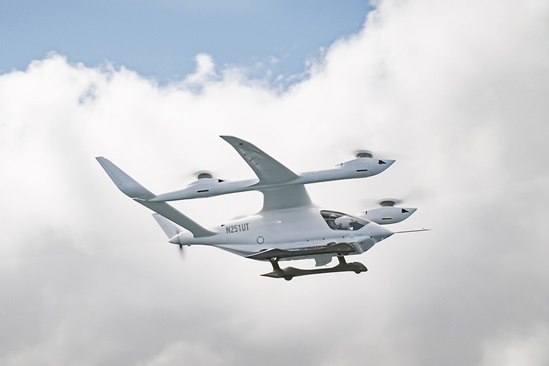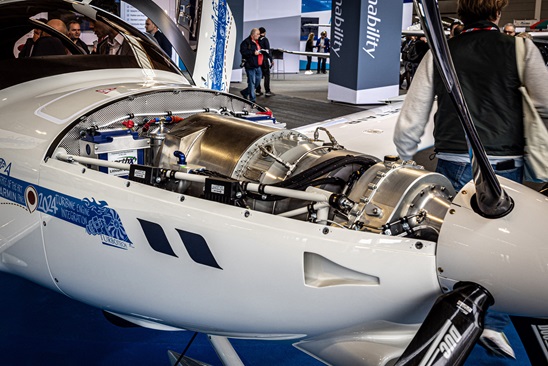In 2008, Embraer’s executive jet division began defining the design concepts for what it would call its “mid-light” and “mid-size” business jets, dubbed MLJs and MSJs at the time. Then-Chief Operating Officer Marco Túlio Pellegrini summarized the strategizing sessions by saying that the goal was to “leapfrog” the competition by providing products with the technology, ergonomics, and economics that would beat the midsize Citations, Challengers, Learjets, and Gulfstreams as they were anticipated to evolve over the next five years. It was a tall order, especially since Embraer was simultaneously involved in ramping up its Phenom 100 and Phenom 300 light-jet programs.
Flash forward to 2015. I’m in a briefing room at Embraer’s final assembly facility at Melbourne International Airport in Florida, eagerly awaiting my flight in the company’s recently certified Legacy 500—the one-time MSJ. My demonstration pilot, Claudio Camelier, and product strategy specialist Alvadi Serpa Jr. are getting me ready for the left seat.
Fly by wire
A big part of Embraer’s Legacy 500 leapfrog strategy is fly-by-wire (FBW) flight controls. With FBW, there are no cables, pulleys, bellcranks, pushrods, or any other mechanical connections between the cockpit and primary control surfaces. Instead, digital commands from the cockpit flight controls pass via digital data buses to a primary flight control computer, then on to hydraulic actuating units at the control surfaces.
The flight control computer, which has two modes, does more than pass along commands and follow the autopilot. In normal mode, flight control laws automatically provide flight envelope protection and auto-trim functions, maintain the airplane’s flight path, and can even command a zero-sideslip condition in the event of an engine-out situation.
The normal-law flight envelope limits bank to 35 degrees, and pitch to plus 30/minus 15 degrees. Airspeed limits are 1.13 VSO and VMO. There’s automatic pitch and yaw compensation in turns, and automatic roll compensation in a sideslip—so yaw/roll coupling is suppressed.
If any of the envelope protection functions are lost—events which Embraer says would have a one-in-a-billion chance of happening—the system reverts to direct mode. Now the airplane has no envelope protection, and flies like a conventional airplane.
Under normal control law, there are sublaws for takeoff and landing. For example, during the takeoff run, the steer-by-wire system limits nosewheel travel from 62 degrees of travel (at low speeds) to a mere three degrees as speed builds. At 65 knots, the airplane goes into takeoff mode, which brings on a pitch rate control that dampens pitch after takeoff so there’s a smooth pitch capture as the airplane rotates. Three seconds after takeoff, the airplane enters flight mode, which puts path control as a priority.
Prior to landing, and with gear down and flaps 3 (full down), normal law puts you in what Embraer calls trim control system (TCS) trim mode. This is designed to give the pilot a traditional trim feel. As the airplane slows, the pilot can retrim in pitch using a TCS button on the sidestick. Press the button, and the airplane will trim to the airspeed that exists before the button is activated. As pitch or airspeed changes coming down final, the pilot will feel the typical need to pull or push on the sidestick, but pressing the TCS will trim out the control pressures the same way a conventional, manual pitch trim input would.
Speaking of sidesticks, they self-center with hands off and use a spring mechanism to provide a measure of artificial control feel. The sticks are not mechanically connected, and the Legacy 500 uses a system that warns pilots when both are making control inputs at the same time. Both sticks vibrate, and aural and visual “dual input” callouts occur. Pressing the AP/PTY button on the sidestick gives control to the last pilot who pressed it.
Strapping in
Embraer calls the Legacy 500 a mid-size jet, but walk up to it and the impression is one of a much larger airplane. Go up the airstair door, hang a left through the galley, and you’ll see an expansive cockpit, made all the more so by the absence of centrally located control yokes. The windshields give you a great wraparound view, but it’s the Rockwell Collins Pro Line Fusion avionics suite that dominates the scenery inside. Synthetic vision includes transparent airport domes for the departure, destination, and alternate airports, plus magenta lead-in lines to the selected landing runway.
In keeping with the path-based navigation philosophy, there are green flight path vector symbols to show where the airplane is going, plus a circular magenta guidance cue symbol from the flight director, which shows your orientation to the desired flight path. Keep the magenta circle within the flight path marker, and you’re complying with the commands you’ve selected with the glareshield-mounted autopilot/flight director controls.
Camelier and I went through a list of 25 tasks in the day’s flight profile, beginning with programming the Pro Line Fusion with our weight (31,965 pounds, including 6,600 pounds of fuel, which was 5,954 pounds under the 500’s maximum takeoff weight), and METAR data. We had four passengers, and entered their weights and seat locations. Using the center pedestal-mounted trackballs, it was a matter of a few mouse clicks and presto: our V-speeds, takeoff distances, and weight and balance information were calculated and presented automatically.
The Fusion’s interactive functions would track our fuel burn and weight as we flew, and later give us our landing V-speeds and CG position. Meanwhile, the upper multifunction display (MFD) showed airport, taxi diagrams, and approach and departure charts. The lower MFD can also be configured to give many screen views, including system synoptic pages and much, much more system information.
Taxiing took some practice (there is no tiller) but by the time I got to the threshold of Melbourne’s Runway 27L, I was much smoother on the rudder pedals. For takeoff, it was line up, engage the autothrottles by bringing the thrust levers up about halfway; then the system automatically takes them to the takeoff thrust position. A moment’s hesitation, and then it was hang on as the 500’s Honeywell HTF7500E engines’ full 13,080 pounds of thrust kicked in.
V1 (109 knots) and VR (114 knots) sped by in seconds, Camalier raised the landing gear, and we were at our final segment climb speed of 143 knots—and going up to the tune of 4,500 fpm. We needed 3,448 feet of runway for the takeoff, according to the Fusion’s calculations, and that was with us using flaps 1; with flaps 2, we would have needed just 3,064 feet.
ATC vectored and step-climbed us around for a bit, but eventually we entered a 280-knot climb to FL450. There, power was set for high-speed cruise, and the numbers for our weight and ISA-minus-6-degree condition were: Mach 0.81 (460 KTAS), using an N1 of 85.8 percent and a total fuel burn of 1,520 pph, or about 226 gph. For long-range cruise we saw Mach 0.76 (407 KTAS) with 78.4 percent N1, burning 1,080 pph, or about 161 gph.
After descending to a block altitude of 6,000 feet to 10,000 feet, it was time to try out the FBW’s envelope protection. Bank 45 degrees and pull the stick back to the stop? No problem. The system kept us within the 2.5-G load limit, and by releasing the stick the airplane automatically banked back to its 35-degree limit.
For a check of low-speed protection in the clean configuration, I hand-flew and slowed to 106 KIAS, where the “low speed” aural command came on. But the FBW’s normal law prevented a stall by limiting angle of attack—even though my sidestick was held back to its stop. Because of the FBW’s envelope protection, the 500 doesn’t need a stick shaker or pusher. And if the autothrottles were engaged, they would have automatically brought up the power. The takeaway: You not only have stall protection, but the system will maintain the maximum coefficient of lift during wind shear or terrain-clearance escape maneuvers.
In the landing configuration we were flying at 90 KIAS and under complete control. This was an odd feeling, to say the least. I mean, our deck angle was way up there; we’re flying at piston-single approach speeds, banking this way and that; and yet the airplane must have weighed 30,000 pounds.
Overspeed protection works on the same principle—come up against redline and automatic nose-up commands will keep you from blowing past VMO or MMO, and the autothrottles will go to idle thrust if they’re engaged.
Now that I’m a believer in envelope protection, Camalier reaches down, flips up the cover of a red guarded switch labelled Direct, and pushes it. Now we’re in normal law.
Would I like to try an approach to a stall? Why not, I say to myself, wondering mightily what the stall behavior might be in a swept-wing airplane like this. But no worries. There’s aerodynamic buffeting for advance warning, plus the high AOA cues on the PFD, plus the “low speed” aural warning; simply lowering the nose and adding thrust quickly sent us north of 200 KIAS.
Landing
By the time we returned to Melbourne I’d had enough time to get a decent feel for the airplane. For an airplane of its weight and size, the Legacy 500 responds far more nimbly than I anticipated. This came in handy for my landings, where the drill is to slow to 210 KIAS approaching the airport; go to 180 knots on downwind or nearing an initial approach fix; go to flaps 1, then 160 KIAS turning base or approaching a final approach fix; extend the landing gear; and ultimately go to VREF and flaps 3 for the final approach segment. At our landing weight of 27,767 pounds our VREF was calculated as 121 KIAS.
VREF and flaps 3 brings you into TCS mode, so there’s no more autotrim and any pitch trimming must be done with the TCS button. Over the threshold, flare at about 10 to 20 feet (an enhanced ground proximity warning system—EGPWS—callout counts down your height above the runway), hold the nose off as normal, let the mains touch down, then apply brakes and reverse thrust. I went easy on the brakes, but Camalier said that with maximum braking and reverse thrust, landing ground rolls typically run around 1,650 feet thanks to brake-by-wire and antiskid.
In all, I had two instrument approaches, five touch and goes, and one landing to a full stop. By the third landing I had pretty much come to terms with the 500’s behavior and even brought myself to follow Camalier’s suggestion to fly in a crab (there was an 11- to 18-knot crosswind) on short final, then kick it out right before landing. The upwind wing didn’t rise very much because of the FBW’s roll suppression, so very little aileron was needed to deal with the crosswind.
But for me the FBW’s biggest draw came when Camalier pulled an engine after a touch and go. I was amazed at how the airplane handled the situation. It automatically applied the proper rudder pressure, and moved the ailerons to create a zero-sideslip condition. It didn’t do all the work—which is by design so pilots retain a tactile recognition of asymmetric thrust. But it did “about 80 percent of it,” according to Camalier. If I had done nothing, the 500 would have climbed away slightly off runway heading, and in a shallow bank.
Bottom line
Embraer is on the move. Ten years ago the Phenoms, the Legacy 500, and the Melbourne facility didn’t exist. Today the Phenoms are cleaning up in the light jet market, and the Legacy 500 is poised to make a dent in the mid-size market. At first conceived as a competitor to Cessna’s Citation Sovereign+—and Gulfstream’s G150 and G280—its spacious, well-appointed cabin and flat floor make Bombardier’s Challenger 350 its closest competitor. This, along with its ramp presence, psychological feel, and 3,000-nm range, puts the Legacy 500 at the threshold of big-jet country.
Email [email protected]
Photography by Chris Rose
SPEC SHEET
Embraer Legacy 500
Base Price: $19,995,000
Specifications
Powerplants | (2) Honeywell HTF7500E, 6,540 lb st ea
Recommended TBO | On condition
Recommended HSI | On condition
Length | 68 ft 1 in
Height | 21 ft 2 in
Wingspan | 66 ft 5 in
Wing area | 483 sq ft
Wing loading | 78.5 lb/sq ft
Power loading | 2.9 lb/lbst
Seats | 2 + 8/12
Cabin length | 27 ft 6 in
Cabin width | 6 ft 11 in
Cabin height | 6 ft
Basic operating weight | 23,437 lb
Max ramp weight | 38,095 lb
Max takeoff weight | 37,919 lb
Zero fuel weight | 26,499 lb
Max useful load | 14,658 lb
Payload w/full fuel | 1,600 lb
Max landing weight | 34,127 lb
Fuel capacity | 1,949 gal 13,058 lb
Baggage capacity, internal | 330 lb, 40 cu ft
Baggage capacity, aft | 882 lb, 110 cu ft
Performance
Balanced field length, SL @ 15 deg C/59 deg F | 4,084 ft
Balanced field length, 5,000 ft @ 25 deg C/77 deg F | 5,417 ft
Max demonstrated crosswind component | 25 kt
Rate of climb, sea level | 3,866 fpm
Single-engine ROC, sea level | 841 fpm
Cruise speed/range w/NBAA fuel reserves (fuel consumption) @ Max cruise power, 45,000 ft | 448 kt/ 3,000 nm (1,733 pph/259 gph) @ Max range setting, 45,000 ft | 433 kt/ 3,125 nm (1,724 pph/257 gph)
Max operating altitude | 45,000 ft
Single-engine service ceiling | 28,992 ft
Sea-level cabin to | 26,520 ft
Limited and recommended airspeeds
VR (rotation) | 113 KIAS
V1 (takeoff decision speed) | 113 KIAS
VMCG (min control w/one engine inoperative, ground) | 98 KIAS
VMCA (min control w/one engine inoperative, air) | 103 KIAS
V2 (takeoff safety speed) | 120 KIAS
VA (design maneuvering) | 205 KIAS (up to 20,000 ft)
VFE (max flap extended) | 210 KIAS (Flap 1)
VLE (max gear extended) | 250 KIAS
VLO (max gear operating)
Extend | 250 KIAS
Retract | 250 KIAS
VREF (reference speed, final approach) | 102 KIAS (4 pax + reserves)
VMO (max operating speed) | 320 KIAS
MMO (max Mach number) | M 0.83
VSO (stall, in landing configuration) | 83 KIAS (4 pax + reserves)
Extra: Should an engine lose power, the fly-by-wire system will automatically apply most of the required corrective control inputs.
For more information contact Embraer representatives online.
All specifications are based on manufacturer’s calculations. All performance figures are based on standard day, standard atmosphere, sea level, gross weight conditions unless otherwise noted.
Extra: View the video.
















